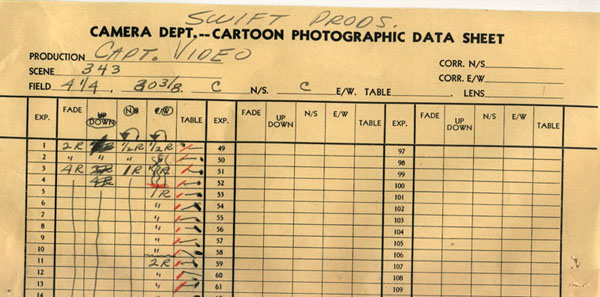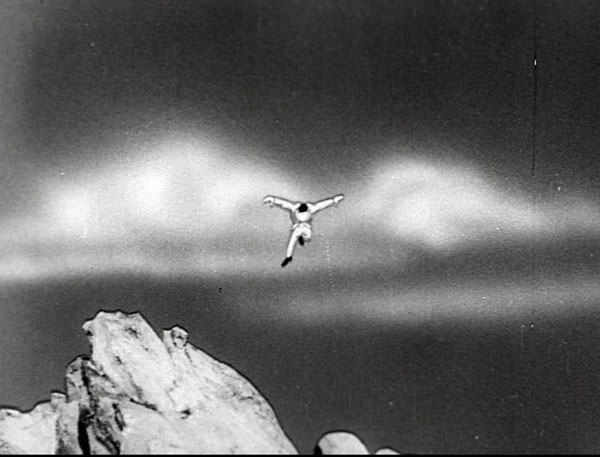
In the summer of 1993, I (on behalf of Asifa Hollywood) got involved with organizing the Ojai Animation Festival, a short-lived but wonderful weekend out of town, that attracted many from the Hollywood community for a series of talks, screenings and previews of forthcoming animation. It was there I met Ginny Swift, of the Ojai Film Society which partnered with us to put the event on.
Ginny was the widow of animator Howard Swift and was quite involved with his latter work as an independent commercial animator. Though Swift ended his career animating on staff for Hanna Barbera in the 60s, 70s and into the 80s, he began it at the Disney studio in the 1930s. He was picked off the Disney picket lines to join the group Frank Tashlin was assembling at Screen Gems (Columbia) where he went from animator to director during the wartime years.
When Screen Gems closed in 1946, Swift teamed with producer Charles F. Chaplin to create Swift-Chaplin Productions to make industrial films and ultimately animated commercials for the new world of television. At one point early in the festival planning, I had asked Ginny about some of her experiences working with Howard. She immediately began telling me about their working with Columbia Pictures producer Sam Katzman to do the flying animation of Superman.
Little did Ginny know, I was a big fan of those Saturday matinee serials, and was quite familiar with Sam Katzman’s films – and his ultra low budgets. She had just answered one of my Holy Grail questions: Who did the animation in those Columbia serials? Now we know: Howard Swift – the man who animated half of “Pink Elephants On Parade” in Dumbo, part of “Dance of The Hours” in Fantasia, directed the Fox & Crow, the short-lived L’il Abner and the ill-fated Flippy cartoons for Columbia.
Apparently, Superman was supposed to fly in some way similar, but inferior, to the Lydecker’s expert effects in Republic’s The Adventures of Captain Marvel. Or at least they tried…

It didn’t work. Someone, most likely director Spencer Bennet, recalled some tricks used back in the silent era – replace the human Superman with an animated one. A cartoon animated one. At the eleventh hour Swift was called in to the set and helped stage the shots so they had the “backplate” for Superman to fly over. In retrospect, Swift did an incredible job – but the kids didn’t buy it. It was an obvious cheat. Despite advertising that promied this wasn’t a cartoon… it was a cartoon.

However Superman was so popular, actor Kirk Alyn so appealing and the serial was so successful – it seemed no one really cared. Audiences went along with it. In fact, they demanded a sequel.
First, here’s a clip of the animation from Superman (1948):
Katzman knew he had something here – a low cost way to do special effects he couldn’t begin to afford. The producer kept Swift busy for the next few years. In 1949, Katzman produced a serial based on the aviation comic strip Bruce Gentry. Tom Neal starred and was threatened throughout fifteen chapters by mysterious flying discs – the discs provided by Howard Swift:
In 1950, Katzman came through with a sequel, Atom Man Vs. Superman. This one was better in several ways, not the least of which was casting Lyle Talbot as Luthor. This time they knew they were going to use animation, so the planning was better, and Katzman seemed to give Swift a few more bucks to give the cartoon effects more shading and nuance – barely. Katzman saved a few bucks, however, by re-using all the Bruce Gentry flying saucer footage as Luthor’s secret atomic weapons.
In 1951, Katzman brought to the screen the infamous Captain Video – the first TV-to-movie adaptation ever. A perfect place to use Swift for space ships and other outer space effect shots… here’s a small sample:
Years later, while researching Glenar Productions paperwork in the Asifa-Hollywood archive (Glenar was an animation camera service in Hollywood), I found these papers relating to Howard Swift’s work on the Captain Video serial. Below, part of an exposure sheet; below that, the work order for two sequences “Pan of Rocket” and “Truck in on Planet”.


As serials waned in the 1950s, Swift was used less and less… his final bits for Katzman were in The Lost Planet (1953) – for cliffhangers like this:

From “The Lost Planet” (frame grab courtesy of Eric Stedman)
As funky as these effects are, Katzman and Swift were actually way ahead of their time. Today when Spiderman swings over Manhattan, or when Superman, Green Lantern, Thor and Iron Man fly into action, the live action actors are replaced by CG animation. Same idea – newer techniques.
If it were up to me, I’d turn them into two-dimensional cartoons – just like the old days. It’s a lot more fun.


 Jerry Beck is a writer, animation producer, college professor and author of more than 15 books on animation history. He is a former studio exec with Nickelodeon Movies and Disney, and has written for The Hollywood Reporter and Variety. He has curated cartoons for DVD and Blu-ray compilations and has lent his expertise to dozens of bonus documentaries and audio commentaries on such. Beck is currently on the faculty of CalArts in Valencia, UCLA in Westwood and Woodbury University in Burbank – teaching animation history. More about Jerry Beck [
Jerry Beck is a writer, animation producer, college professor and author of more than 15 books on animation history. He is a former studio exec with Nickelodeon Movies and Disney, and has written for The Hollywood Reporter and Variety. He has curated cartoons for DVD and Blu-ray compilations and has lent his expertise to dozens of bonus documentaries and audio commentaries on such. Beck is currently on the faculty of CalArts in Valencia, UCLA in Westwood and Woodbury University in Burbank – teaching animation history. More about Jerry Beck [



































They must have still felt a bit uneasy with the combination by 1951, since the animation option was never used in the Superman TV series (including the B&W episodes, where they could have simply borrowed from the serials, as they did by turning the Mole Men theatrical into a two-part Season 1 episode. The Season 3 and later ones would have required color animation).
Actually – you just reminded me that Swift contributed one brief animated flying shot – literally two seconds – to Superman and The Mole Men (1951). You can see it at 30:32 here: https://www.youtube.com/watch?v=1hFRyHgKnW0
This shot was cut from the TV episode version, I believe.
Those two Superman serials are surprisingly enjoyable… heaven help me, I’ve watched them through twice! The animation is not at all convincing at what it’s supposed to bridge, but very stylized and unusual.
I’ve read that in the shot of the Joker taking his final fall in Tim Burton’s “Batman,” the figure of the Joker was animated, but I haven’t seen the picture in years to be able to verify if that’s true.
According to the IMDB, yes, the Joker’s fall to his death in the Tim Burton BATMAN was animated. I have that on DVD but it’s packed right now and I can’t get to it easily, or I’d check.
I can confirm this as well. I remember the scene where the Joker takes his suicide jump with the camera’s view from the ground. It’s a one-second shot, so you have to keep your eyes fixed from the moment Joker falls back first when the shot cuts to the scene.
I love the two Columbia Superman serials! True, they are not as good technically as Republic’s Adventures of Captain Marvel (with real flying shots), but still quite enjoyable.
I think that Sid Glenar was one of Harman-Ising’s camera people. The note signed “Boggs” is Al Boggs, who was a tech. at Screen Gems and had his own little company for awhile, he probably worked with Howard Swift in production. Not sure who “Jay” is, but he might have been one of Howard Swift’s animators on these effects sequences, Howard Swift did not do all the animation by himself.
I STILL think that Pixar could make the ultimate SUPERMAN movie, with Joe Shuster’s art as inspiration for the overall character design.
Say, I can dream, can’t I?
So, in other words, you want Pixar to make a hand-drawn feature? Fantastic idea!
Super-article or blog or whatever its called. The only thing equal to your serial scholarship was seeing tinted Captain Video scenes. Did VCI don this or an enterprising fan? In any event it gives a good idea of how CV might have looked in theaters. Another Cartoon Research steller entry.
The Captain Video clip came from the VCI dvd release. Yes, they accurately restored the tinted Cinecolor sequences – and it makes a big difference.
Uh, hello. Swift-Chaplin Productions? This revelation deserves a story of its own. I know a lot about Chaplin and I never heard the Charlie Chaplin had an animation studio. I must know more. Tell me now. Examples? Did it close upon Chaplin’s banishment from the United States?
You learn new things each day!
Not the same Charles Chaplin. My Father worked for Swift-Caplin and i knew both Howard Swift and Charles Chaplin.
The music that went along with the animation in the Superman serials really worked well in my opinion.
I can see where kids readily recognized the fakery, but was that a dealbreaker? You actually SAW Superman doing stuff, even if it was a cheezy effect.
As a boomer kid seeing this sort of thing on TV, I looked for quantity over quality in effects shows. Lugosi turning into a cartoon bat in “Abbott and Costello Meet Frankenstein” was always a highlight.
Jerry, to your point about going CG whenever movie superheroes go into action, that’s no more believable to me than this stuff is (and this stuff, in the distant shots isn’t that bad). When movie Spider-man swings off a roof and the whole thing turns into a video game, it’s wholly unreal to me, and any sense of danger or drama goes right out the window, because I can’t believe there are people inside those costumes or armor.
Very interesting article about Sam Katzman and Howard Swift. Definitely ahead of their time. However, I thought I would mention two other films where Katzman served as Executive Producer and also involved animation effects. The films were produced by a man named Charles Schneer and animated by a young man named Ray Harryhausen. The films: “Earth vs. The Flying Saucers” and “It Came from Beneath the Sea”.
I remember seeing these before CGI effects existed. While it was obvious that it was a cartoon, I kinda preferred this use of 2D animation over most of the live action effects that would have been used at the time, because at least Superman flew like I always pictured he would.
The Directors Guild of America is seeking the estate of Howard Swift. If you have a moment to contact me, I’d really appreciate being able to speak to you about him and perhaps other animators about whom you might be able to provide information. Thank you – Devin Snell, Estates Manager (devins@dga.org)
I am the granddaughter of Howard E Swift. My mother Diane Jean Kallusky is his daughter.
I think these effects are awesome and always have. You’re talking low budget productions made for kids, they could have gone cheaper and cheesy, think Ed Wood’s flying saucers. Being a kid back then watching this stuff on the big screen must have been awesome.
like to have some dvd of them